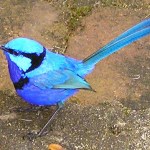Sexual Behavior and Mating
Welcome to the second installment of Animal Territoriality Week. Today, we'll look at a case where differences in territory size can have implications for neuroanatomy. If you missed part 1 of Animal Territoriality week, check it out here.
Let's say you have two very very closely related species. You might even call them congeneric, because they are from the same taxonomic genus. In most ways, these two species are very similar, but they differ behaviorally in some very big ways. Might those behavioral differences predict neurobiological differences?
The different species of the genus…
Painstaking scientific research has identified seven dating tips that could boost your chances on Valentine's Day ... including shouting in his right ear and scaring him witless.
Whether or not you have a Valentine this year, head on over to check out to my latest piece in The Guardian: Valentine's Day dating tips from lovestruck scientists.
Photo: Getty Images/Brand X
What's the best way for a lonely guy to get a date? If you're a Splendid Fairy-Wren (Malurus splendens, native to Australia), your best bet might be to frighten the object of your affection.
You've learned all about the birds and the bees; now it's time to learn from them.
Lots of research has shown that animals reduce their sexual behaviors when predators are around. After all, it isn't just potential mates who would see or hear an elaborate mating display, but also potential predators. The male splendid fairy-wren does something a little bit unusual, though. Gray Butcherbirds (Cracticus…
Figure 1: A mother hyena with her cubs.
Early developmental experiences can have significant implications for the growth, behavior, survival, and reproductive success of an individual. In many species, one of the most important factors that affects an individual's early development is the maternal environment. However, mothers not only provide an environment for their offspring, but also half of their genes, making it difficult to separate the effects of nature and nurture when investigating developmental outcomes in the offspring. Moreover, because male mammals usually disperse from the…
A fascinating new paper just came out in Nature Communications and I intend to blog it in the usual manner, but I thought I'd try something new first. Check it out:
The Research Question
...According to life history theory, mothers should invest in their offspring if this enhances offspring survival and fitness, and if the fitness benefit to mothers from increased offspring fitness exceeds the cost of their investment. Whether the maternal environment influences the fitness and reproductive value of sons is unknown in most mammals because male mammals usually disperse and, thus, few studies…
"The males often prefer eating to mating."
Apparently, giant panda dudes (Ailuropoda melanoleuca) in captivity would rather sit around and munch on bamboo than get it on with the females. And this is a problem at the Chengdu Panda Breeding and Research Centre, where scientists are urging the pandas to breed, for conservation purposes.
What's the answer to this important problem? Panda porn, of course!
Pandas are known to be isolated creatures and poor breeders, and in captivity the problem may be exacerbated. Zhihe and his team have tried a number of measures to try to cure the male panda of…
Yesterday afternoon, I watched the livestream of the "All Creatures Great and Smart" session of the World Science Festival in New York City. The session was absolutely fantastic, and featured Brian Hare, Vanessa Woods, Jeremy Niven, Patrick Hof and Klaus Zuberbühler.
The conversation challenged long-held assumptions about the differences between "animal" and "human", and included fascinating discussion about pin-sized brains that can count, categorize, and hold a grudge against those who've tried to swat them. Does your dog really think and feel like a human? Do our closest primate…
It should not come as a surprise to the regular reader of this blog that a lot can be learned about animal cognition by simply observing animal behavior. But can observing animal behavior lead the observer to make inferences about brain anatomy? Can observing animal behavior tell us something about the evolution of the brain?
Figure 1: Like the raccoon says.
Let's say you have two very very closely related species. You might even call them congeneric, because they are from the same taxonomic genus. In most ways, these two species are very similar, but they differ behaviorally in some very…
Regular readers of this blog know that while I think studying animal cognition, behavior, and communication is (sometimes) fun and (always) interesting, the real importance - the why should I care about this - is because by understanding animals, we can attempt to learn more about ourselves.
I've written about this before. Here are the relevant excerpts:
When human adults show complex, possibly culture-specific skills, they emerge from a set of psychological (and thus neural) mechanisms which have two properties:
(1) they evolved early in the timecourse of evolution and are shared with other…






